
Flying without wings: Fascinating fliers
Continued from last week
Most of you may have been fascinated by the flying animals that were
featured last week. It is indeed amazing to learn that there are animals
that could at least glide considerable distances without wings, even
though they may not be able to really fly like birds or bats do.
Today, we bring you more information on a few more animals with the
ability to 'fly'. The creatures we feature in our concluding part of
'Flying without wings' are the flying snakes, flying frogs, flying
geckoes and flying lemurs.
The flying gecko
We are used to seeing geckoes in our houses, some of which resemble
dinosaurs in miniature form due to their dark, rough-skinned appearance.
Most of us generally feel squeamish just seeing them moving about on
ceilings and walls. What if they suddenly flew at you like the
cockroaches? Well, you will be surprised to learn that some species of
geckoes can fly.
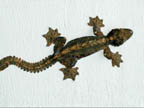
But relax. The geckoes you find in your house will never be able to
do so because flying geckoes live outdoors, mostly on trees.
The flying geckoes, also known as the Thick Fingered Geckoes like all
the other flying creatures, can glide from tree to tree or branch to
branch when they are hungry or scared.
They are nocturnal creatures, and feed primarily on insects. They are
shy animals and usually stay in hiding. Flying Geckoes are found
throughout South East Asia.

These moderately sized lizards can reach up to eight inches in
length. They can blend well with plants, soil and bark, to escape from
predators.
While the average life span of a flying gecko is three years, some
can live up to even eight years and more.
The flying geckoes also have a thin fold of skin that extends from
the feet up the sides of their bodies. It is this skin flap that enables
them to fly or glide from one point to another without wasting time and
energy creeping and crawling all the way, on all fours.
***
Flying snakes
Unlike most snakes that crawl, climb or swim, these snakes know how
to travel in style. How? By flying! Of course in a way, it is an
overstatement to say snakes fly, because they don't really have wings
like birds, or even skin flaps or fins like the other 'flying' animals.
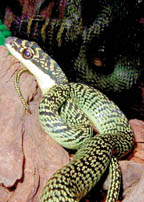
But, their unusual mode of transport, gliding, has been responsible
for these particular snakes being named as flying snakes. So, how do
snakes manage to fly? Do they have a pair of invisible wings? Of course
not. What they do is simply manoeuvre themselves from a high spot and
glide through the air.
When a flying snake wants to get into action and live up to its name,
it climbs to a desirable take-off spot. Then, it dangles from a tree
branch high above the ground, holding on to the branch with its tail. It
hangs like a hook. Suddenly it starts to fall.
Anyone watching it may think it lost its grip and fell. But, this
freefall is no accident. It is how the flying snake launches its flight.
During this process, they flatten the entire body except the tail. To do
this, they suck in their gut and form a U-shaped cylinder with their
entire body. They hold their tail stiffly upwards and twist their tails
from side to side, for balance.
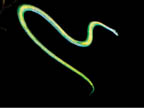
They glide for about 100 metres like this. And as graceful as it may
seem, flying snakes generally crash-land. Flying snakes cannot glide or
'fly' upwards. They are essentially parachuters. They can only glide
downwards.
There are five different species of flying snakes found in the
lowland tropical rainforests of Southeast and South Asia. Most adult
flying snakes are three to four feet long. The smallest species is about
two feet long.
No one knows why they really fly. Normally, they fly from tree to
tree, but sometimes they fly from tree to ground.
Flying snakes are generally considered harmless, however, they could
bite when provoked. Some species are mildly venomous, but usually, only
dangerous to their small prey. Flying snakes also have fangs like other
snakes, but these fangs are in the rear of the mouth, and are only about
2-3 mm long.
Fact file
* Flying snakes are generally active during the day.
* They eat any small vertebrate in the trees such as lizards, frogs,
birds and bats.
* Paradise tree snakes are primarily lizard eaters.
***
Lemurs that fly...
Flying lemurs or colugos are not related to the primates identified
by the same name which we featured..... This group is unique to the
mammalian clan, even though they have lemur-like faces.
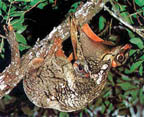
Herbivores by nature, the flying lemurs feed on leaves, flowers,
fruits, and buds. They are considered endangered, as already one of the
existing two families, is extinct. There are only two living species of
flying lemurs today. They are found mostly in Southern Asia and the
Philippines.
What helps them fly?
Like all other flying animals that we have already discussed about,
lemurs too do not really fly like birds or bats, but glide from tree to
tree.

A membrane of skin attached from the neck to the forepaws to the hind
feet and the tip of the tail helps these creatures to glide, sometimes
up to 100 metres from the top of trees.
However, unlike the bat's membrane, it is not supported by the
fingers.
Their appearance...
Flying lemurs are generally brown or grey in colour, covered with
irregular white spots. Their heads are broad and flat. They have feet
which are considerably long, with needle-shaped claws which are also
rather long. Their teeth resemble those of carnivores, even though they
are herbivores in nature.
These living, breathing hand gliders, usually travel upside down like
the sloth, among the branches of the tall trees they live on. When it's
time to fly, they spread their huge wings of skin wide open and glide.
The females give birth to one or two lemur babies which they carry
about on their bodies as they move from place to place.
****
Flying frogs
The flying frogs from the Rhacophorus species such as the
R.reinwardtii. and R.nigropalmus are not very big, like most of the
flying frogs, but they could glide up to 50 feet from tree to tree and
leaf to leaf.
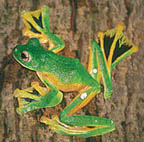
The R. reinwardtii is found in Indonesia, East Malaysia (Subah and
Sarawak in Borneo), Vietnam, China and Lahore. The female flying frogs
reach about 3.5 inches in size but the males are smaller. In fact, most
flying frogs are no bigger than 15-20 mm.
How can frogs fly?
These tiny insectivores with over-sized, but specialised feet like
those of the geckoes, fly with the aid of flaps of skin along the sides
of their bodies and of course their webbed feet, that act like
parachutes.
There are adhesive discs on the tips of their fingers and toes that
act as suction cups as they fly from one place to another.

When they spread their over-sized webbed feet and glide, these tiny
frogs look as if they are true fliers, like the birds and bats.
What they look like
Flying frogs which live in humid tropical rainforests, spend most of
their time on tall green trees.
Their body colours vary from light green to dark green, from species
to species.
Some such frogs have tiny dark spots around the back and head. The
eyes are generally light yellow, greenish or light grey with black
horizontal pupils.
The males are more elaborately coloured in most species, with their
colours ranging from orange, green, purple, black and yellow, on the
sides of the abdomen and the webs of the feet. |


